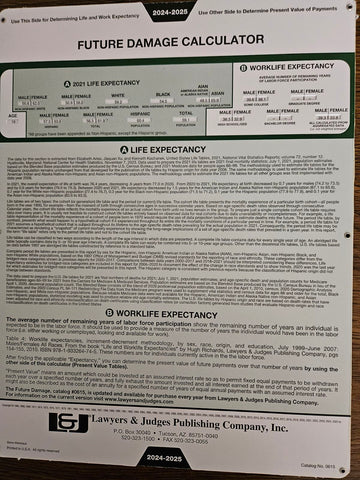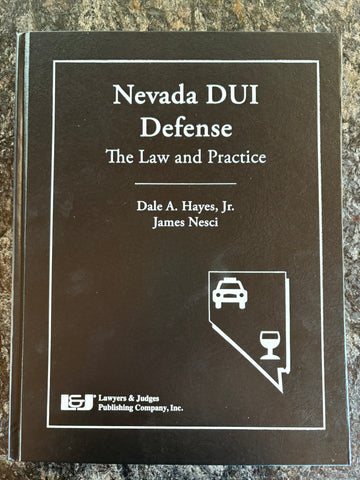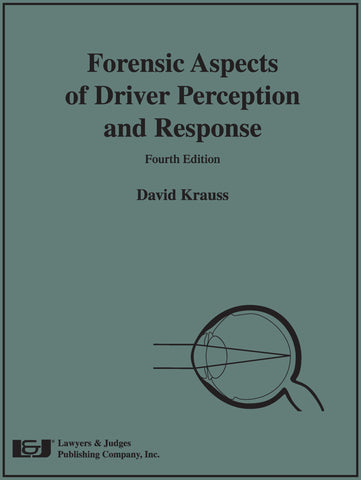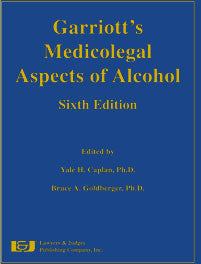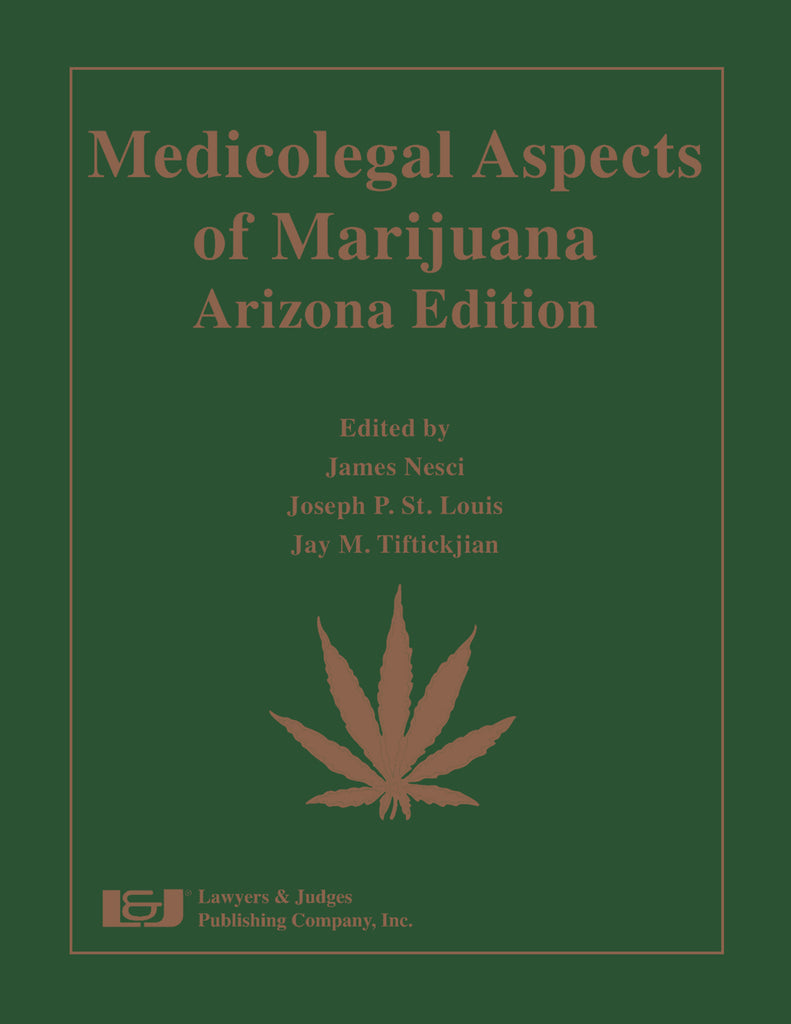
Medicolegal Aspects of Marijuana: Arizona Edition
- Editors: James Nesci, Joseph P. St. Louis, and Jay M. Tiftickjian
- ISBN 10: 1-936360-42-X
- ISBN 13: 978-1-936360-42-0
- Copyright Date Ed: May 2, 2018
- Pages: 304 pages
- Binding Information: Hardcover (with companion DVD)
- Size: 8.5 ✕ 11 Inches (US)
Medicolegal Aspects of Marijuana: Arizona Edition is the hands-down indispensable textbook for attorneys, judges, legislators, and individuals involved in the business of medical and recreational cannabis.
The burgeoning field of marijuana-related litigation in Arizona touches many areas of law, from criminal prosecution, to motor vehicle accidents, to real estate transactions, to business regulation, and to taxation issues. The medicolegal aspects of marijuana are complex topics because so many different components are present in marijuana-related criminal, civil, and administrative litigation.
Forensic marijuana analysis is a new area for most attorneys. It is extremely important that THC analyses be preformed accurately and correctly and that the results are properly interpreted. Often, results are deemed meaningless because samples are mishandled, equipment is incorrectly calibrated, or results are incorrectly reported.
The wealth of information presented in this book makes it an invaluable resource when investigating and litigating cases involving marijuana.
Table of Contents
Table of Cases
Introduction
Chapter 1: A Brief History of Marijuana Legislation in Arizona
Jay Tiftickjian, Esq. & James Nesci, Esq.
1.1 Proposition 200: The Original Arizona Medical Marijuana Legislation
1.2 Proposition 203: The Second Attempt at Medical Marijuana Legislation
1.3 Proposition 205: The Failed Attempt to Legalize Recreational Marijuana
1.4 National Overview and Federal Legislation
Endnotes
Chapter 2: The Arizona Medical Marijuana Act (AMMA)
James Nesci, Esq.
2.1 Overview
2.2 Application of Proposition 105 to the AMMA
2.3 Qualifying Medical Conditions
2.4 Relevant Dispensary Handbook, Statutory and Administrative Code Definitions
2.5 Patient and Caregiver Registration Requirements & Procedures
2.6 Use of Medical Marijuana: Locations and Methods
2.7 Dispensaries, Agents, Locations, Card Verification, & Discrimination
2.8 Governmental Oversight and Reporting
2.9 Funding for the AMMA
2.10 Enforcement of the AMMA
2.11 Firearms
2.12 Use of Medical Marijuana while on Probation
Endnotes
Appendix 2A: Title 9 Health Services—Chapter 17. Department of Health Services Medical Marijuana Program
Chapter 3: Business Regulation and the Enforcement Process for Arizona Medical Marijuana Law
James Nesci, Esq.
3.1 Brief History of the Development of Medical Marijuana Businesses in Arizona
3.2 State and Federal Enforcement Priorities
3.3 General Business Structure
A. Restrictions on Ownership Interests
B. Medical Directors
C. Agent, Caregiver, and Consultant Restrictions
D. Change of Ownership Issues
E. Cultivation Sites
F. Security Requirements
G. Infusion Kitchens & Edibles
3.4 State Enforcement Actions
Endnotes
Chapter 4: Banking and Taxation for the Marijuana Industry
Jim Marty, CPA, ABV, MS, Kyle Walker, MBA, and James Nesci, Esq.
4.1 Introduction
4.2 Lack of Access to Banking
A. Federal Regulation
B. Arizona Department of Revenue
C. Department of Justice Guidance Memo
D. The Financial Crimes Enforcement Network
4.3 The 280E Problem
A. Basis Issues and Other Unintended Consequences
B. The History of 280E
C. Why is Cost of Goods Sold Deductible?
D. Is 280E Constitutional?
E. Conclusion
Endnotes
Chapter 5: Land Use, Real Estate, and Landlord/Tenant Issues
James Nesci, Esq. & Bill E. Kyriagis, Esq.
5.1 Overview
5.2 Dispensaries & Cultivation Sites
A. Zoning
B. Dispensary Allocation & Applications
C. Community Healthcare Analysis Areas (CHAA)
5.3 AMMA Patient Marijuana Activities
A. Limitations on Possession and Public Consumption of Marijuana
5.4 Landlord/Tenant Issues
A. Introduction
B. Federal Criminal Law and Asset Forfeiture
C. Federal Policy Memoranda and Federal Enforcement In Practice
D. Minimizing Federal Enforcement Risk
E. Lease Termination
F. Bankruptcy Issues
G. Contractual Obligations & Collateral Issues
H. Landlord/Tenant Practical Considerations
I. Landlord/Tenant Issues Relating to AMMA Patient Consumption of Marijuana
J. Federal Requirements Imposed by the US Department of Housing and Urban Development
Endnotes
Chapter 6: Federal Controlled Substances Laws and Marijuana
Andres R. Guevara, Esq. & James Nesci, Esq.
6.1 Introduction
6.2 The Reach of Federal Jurisdiction—the Long Arm of the Law
A. The CSA and Marijuana Enforcement
B. The Power of the Commerce Clause
C. Supremacy and Preemption
D. How the AMMA Survives Preemption
6.3 Federal Marijuana Sentences/Charges
A. Federal Sentencing Generally
B. Marijuana Sentences and Charges Under the Federal System
6.4 Federal Marijuana Reform and Trends
Chapter 7: Arizona Criminal Marijuana Statutes and Penalties
James Nesci, Esq.
7.1 Overview
7.2 Definitions
7.3 Possession
7.4 Minors, Communications and Buildings
7.5 Penalties
7.6 Drug Court
7.7 Proposition 105 Warning
Chapter 8: Driving, Boating, & Flying Under the Influence of Marijuana
James Nesci, Esq.
8.1 Misdemeanor DUI: Major Changes
8.2 Case-Law, DUI, and the Effect of the AMMA
8.3 Extreme DUI Does Not Apply
8.4 Prior Offenses in Misdemeanor Cases
8.5 Aggravated DUI
8.6 Ignition Interlocks
8.7 Pleas to Endangerment
8.8 Reckless Driving
8.9 Homicide
8.10 Minor Driving with THC
8.11 No Impoundment of Vehicles
8.12 Sentencing: Statutory Scheme
8.13 Probation
8.14 Costs of Incarceration
8.15 Reimbursement for Emergency Response
8.16 Restitution
8.17 Misdemeanor BUI: Overview
8.18 Aggravated BUI
8.19 Minor Boating with THC in the Body
8.20 FUI: Flying Under the Influence
8.21 Federal Court Jurisdiction
8.22 Government Oversight, DUI Abatement and Money
Appendix 8.1
Appendix 8.2
Appendix 8.3
Appendix 8.4
Chapter 9: Drug Recognition Evaluation
James Nesci, Esq.
9.1 Overview
9.2 DRE Nationwide Law Comparison
9.3 DRE Admissibility Case Law
9.4 The 12-Step DRE Protocol
9.5 Deconstruction and Analysis of the 12-Step DRE Protocol
9.6 Effects of Various Drugs
9.7 Drug Evaluation Classification Protocol (DECP) Training Program
9.8 Arizona DRE Statutes
Endnotes
Chapter 10: Pharmacology of Marijuana
James T. O’Donnell PharmD, MS, FCP, ABCP, FACN and James J. O’Donnell III MS, PhD
10.1 Introduction
A. Source of Marijuana and Active Cannabinoid Compounds
B. Kinetics
C. Dynamics—Site of Action; Cellular Receptors for THC
10.2 Current Use of Prescription Cannabinoids
A. Food and Drug Administration Approved Cannabinoid Use
B. Commercial Prescription Cannabinoid
C. Package Insert Warnings
D. Widespread Uses for Medical Conditions
10.3 Marijuana Research
A. Clinical Trials Primer
1. Design
2. Double blinding
3. Limitations of clinical research
10.4 Therapeutic/Medical Use of Marijuana
A. Antiemetic and Appetite Stimulant
B. Decrease in Opiate Craving and Drug Abuse Potential
10.5 Marijuana Toxicities and Risks
A. Physical Effects
1. Eyes and heart
2. Lung effects
3. Blood pressure and heart disease
4. Immune system
B. Tolerance and Physical Dependence—Acute and Chronic Intoxication
1. Effects on behavior
2. Effect of route of administration
3. Amotivational syndrome—loss of interest
4. Duration of effects
5. Complex behavioral changes
C. Cognitive Deficiencies: Intoxication and Impairment—Temporary or Permanent?
1. Age of onset of use
2. Attention tasks
3. Reversibility of cognitive impairment?
4. Receptor downregulation—tolerance
5. Withdrawal
D. Marijuana Abuse and Treatment
10.6 States Which Have Approved Use of Medical Marijuana for Specific Qualifying Medical Conditions
10.7 Conclusion
Endnotes
Chapter 11: Under the Influence of Marijuana
John P. Bederka, Jr., Ph.D. and Warren Cooper
11.1 Under the Influence: After Smoking
A. Introductory Summary
B. Questions in Search of Answers
C. Scientific Data Relating to THC
1. Blood THC v. brain THC: any relationships?
2. Relationships between percent plant-THC and plasma-THC
3. Relation between degree of “High” and plasma THC
4. Occasional marijuana users v. practiced users
5. Is THC the only psycho-active cannabinoid?
6. Urine testing for cannabinoids: clinical or evidentiary value?
7. Impairment & marijuana: laboratory and on-road data
D. Conclusions
11.2 Under the Influence: After Ingestion
A. Introductory Summary
B. Some Comparative Data On Smoking And Ingesting Cannabis
1. How do bioavailability measures relate to Ingestion?
2. Is Dronabinol administration a good model for cannabis Ingestion?
3. Any overall advantages of the oromucosal route?
4. Can the effects after ingestion of cannabis be made more objective?
C. Conclusions
Endnotes
Chapter 12: Are THC Concentrations Appropriate For Presuming Psychomotor Impairment?
Paul Armentano & James Nesci, Esq.
12.1 Overview
12.2 Arizona’s Impairment Standards
12.3 Are THC Concentrations Accurate Predictors of Cannabis-Induced Impairment?
12.4 Why Are Presumptive THC Limits Inadvisable for Cannabinoids?
12.5 Experienced Cannabis Consumers Exhibit Tolerance to the Drug’s Effects
12.6 Cannabis’ Influence on Psychomotor Performance is Short-Lived
12.7 THC/Blood Collection—Timeliness Considerations
12.8 Conclusion
Endnotes
Chapter 13: Laboratory Testing for THC and other Drugs
James Nesci, Esq., John L. Lombardi, Ph.D. & Jeremy Brehmer, Esq.
13.1 Introduction
13.2 Marijuana Pharmacology: Pharmacokinetics of THC
13.3 Urine Sample Collection
A. Sample Collection
B. The Urine Collection Kit
C. Proper Specimen Handling
D. Transportation and Storage
E. Chain of Custody
13.4 Blood Sample Collection
A. Phlebotomist vs. Venipuncturist: What’s in a name?
B. The Blood Kit
C. Storage of the Unused Blood Collection Kit
D. Health Issues and Allergies
E. Proper Site Selection
F. Subject Positioning
G. Site Cleansing
H. The Blood Draw
I. Tube Inversion
J. Chain of Custody and Proper Handling of Specimens
K. Preparation of the Sample for Testing
13.5 Blood Testing for Drugs
A. Overview
B. Evidence-Sample Documentation and Chain of Custody
13.6 Preliminary Drug-Screening Tests
A. ELISA—Enzyme-Linked Immunosorbant Assay
B. Example: THC “Detected” ELISA Screening Result
C. Less-Common Methods of Preliminary Testing
1. Point of Collection Immunoassay (PCI)
2. Enzyme Multiplied Immunoassay Technique (EMIT)
3. Radioimmunoassay (RIA)
13.7 Confirmatory Testing
A. Liquid Chromatography/Mass Spectrometry
B. Gas Chromatography/Mass Spectrometry
C. Total Ion Count vs. Selective Ion Monitoring
13.8 Urine Testing for THC and Other Drugs
A. Application in Arizona
B. Extraction
13.9 Solid Dose Screening Tests
A. Microscopic Morphological Screening Examination
B. Thin Layer Chromatography Screening Test
C. Modified Duquenois-Levine Color Screening Test
13.10 The Laboratory Environment
A. Quality Control/Quality Assurance
B. Analysts (Training and Proficiency)
C. Analysts (Qualifications and Permitting)
13.11 Method Validation
13.12 Blood Draws: Statutory Admissibility, Sample Preservation and Independent Testing
13.13 Secondary Blood Testing
Endnotes
About the Contributors
Index

